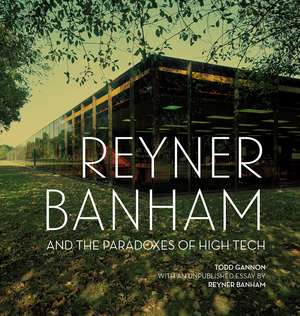Reyner Banham and the Paradoxes of High Tech
Autor Todd Gannonen Limba Engleză Hardback – 14 sep 2017
Reyner Banham and the Paradoxes of High Tech reassesses one of the most influential voices in twentieth-century architectural history through a detailed examination of Banham’s writing on High Tech architecture and its immediate antecedents.
Taking as a guide Banham’s habit of structuring his writings around dialectical tensions, Todd Gannon sheds new light on Banham’s early engagement with the New Brutalism of Alison and Peter Smithson, his measured enthusiasm for the “clip-on” approach developed by Cedric Price and the Archigram group, his advocacy of “well-tempered environments” fostered by integrated mechanical and electrical systems, and his late-career assessments of High Tech practitioners such as Norman Foster, Richard Rogers, and Renzo Piano.
Gannon devotes significant attention to Banham’s late work, including fresh archival materials related to Making Architecture: The Paradoxes of High Tech, the manuscript he left unfinished at his death in 1988. For the first time, readers will have access to Banham’s previously unpublished draft introduction to that book.
Taking as a guide Banham’s habit of structuring his writings around dialectical tensions, Todd Gannon sheds new light on Banham’s early engagement with the New Brutalism of Alison and Peter Smithson, his measured enthusiasm for the “clip-on” approach developed by Cedric Price and the Archigram group, his advocacy of “well-tempered environments” fostered by integrated mechanical and electrical systems, and his late-career assessments of High Tech practitioners such as Norman Foster, Richard Rogers, and Renzo Piano.
Gannon devotes significant attention to Banham’s late work, including fresh archival materials related to Making Architecture: The Paradoxes of High Tech, the manuscript he left unfinished at his death in 1988. For the first time, readers will have access to Banham’s previously unpublished draft introduction to that book.
Preț: 353.15 lei
Nou
Puncte Express: 530
Preț estimativ în valută:
67.58€ • 70.13$ • 56.49£
67.58€ • 70.13$ • 56.49£
Carte indisponibilă temporar
Doresc să fiu notificat când acest titlu va fi disponibil:
Se trimite...
Preluare comenzi: 021 569.72.76
Specificații
ISBN-13: 9781606065303
ISBN-10: 1606065300
Pagini: 256
Ilustrații: 21 color and 101 b-w illustrations
Dimensiuni: 254 x 279 x 33 mm
Greutate: 1.91 kg
Ediția:1
Editura: Getty Publications
Colecția Getty Research Institute
ISBN-10: 1606065300
Pagini: 256
Ilustrații: 21 color and 101 b-w illustrations
Dimensiuni: 254 x 279 x 33 mm
Greutate: 1.91 kg
Ediția:1
Editura: Getty Publications
Colecția Getty Research Institute
Notă biografică
Todd Gannon is professor and head of the architecture section at The Ohio State University’s Knowlton School. He is the coeditor of A Confederacy of Heretics (Getty Publications, 2013).
Recenzii
“As such, Gannon’s book is an encyclopedic recounting of the growth of England’s architectural culture during Banham’s purview. . . If one wishes to understand the gestation of this important movement in modern architecture, there are more revelations, more ‘gotcha’s,’ and more keen observations (with Gannon as guide) than one is likely to find in a decade-long subscription to Architectural Review. As a bonus, it’s even fun to read!”
“Reynam Banham and the Paradoxes of High Tech is a serious-minded book which rounds off Banham’s career but also provides an introduction to his work. It is well-researched and well-written and if you are interested in good critical writing about architecture, it is a great place to start.”
“ . . . Gannon’s text is instructive, giving us cause to read Banham again with fresh eyes and clearer context when we do.”
“Todd Gannon’s Reyner Banham and the Paradoxes of High Tech is a remarkable achievement, breaking new ground despite the substantial volume of publications following the death of Reyner Banham in 1988. It not only recounts the intellectual biography of Banham, commonly portrayed as the inventor of Brutalism or as the promotor of Pop architecture, but more importantly, it establishes him as the spokesperson of a postwar generation, searching for a resolution to an architecture caught between tradition and technology.”
